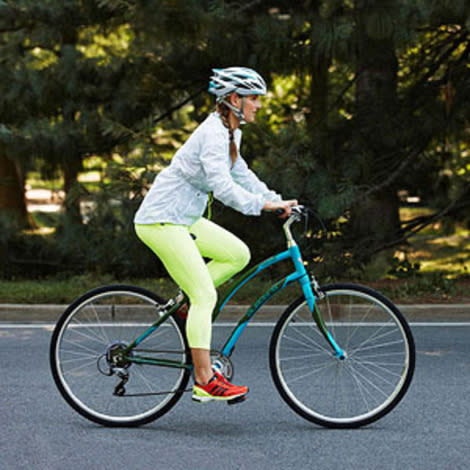Ride On: Everything You Need to Know About Bicycling and Spinning

Cycling is about the most fun you can have burning more than 500 calories an hour. Plus it's so simple anyone can do it. What's stopping you? Get back in the spin with our pedal-pushing pointers.
Related: The Calorie-Blasting Cycling Workout
The Proper Form
Make sure the brim of your helmet is just two fingers' width above your eyebrows. Then tighten the chin strap so you can fit only one or two fingers between it and your chin.
Beginners, position your handlebars at a height at which your back is bent no more than 45 degrees. "The lower you go, the more aerodynamic you may become, but also the greater the potential strain on your back," says Meaghen Harris, who rides for Liv/giant bicycles. (Tour de France contenders typically set their handlebars inches below seat level for that bent-over, streamlined effect.)
Set your seat height so that you have a 25-degree bend in your knee when your foot is at the bottom of a pedal stroke. This will maximize your pedal power, a study in the Journal of Strength and Conditioning Research found.
Choose the Right Bike Size
Your Height | Bike Frame Size* |
|---|---|
5' to 5'3" | XS 13" to 14" |
5'4" to 5'6" | S 14" to 15" |
5'7" to 5'9" | M 16" to 17" |
5'10" to 6' | L 18" to 19" |
*Recommendations from Liv/giant | |
When selecting a bike, height makes right. Brands differ, but use this rule of thumb for frames: As you straddle a road bike just in front of the saddle, you should have at least one inch of clearance from your crotch to the top of the frame. (Allow at least two inches for a mountain bike or a cruiser.)
Related: Find the Right Type of Bike for You
How to Fix a Flat
1. Take the wheel out of the bike frame by releasing the brakes (lift the lever by your seat) and flipping open the quick-release lever -- that little latch attached to the wheel's axle -- then turn your bike over.
2. Wedge the scooplike part of the tire lever from your repair kit in between the wheel's rim and the tire to lift the tire off the rim. (Right, Deluxe Repair and Inflation Seat Bag kit, $33, genuineinnovations.com; innertube sold separately.)
3. Pull the innertube out and, with the patches and rubber cement in the kit (or duct tape, in a pinch), patch any punctures you feel inside the tread.
4. Grab the new innertube from the kit, use your mouth, a mini pump or a CO2 cartridge to slightly inflate the tube, and then feed its valve back through the wheel rim. Stuff the semi-inflated innertube inside the tire.
5. Use the tire lever to gently tuck the tire tread back into the rim; hook the mini pump or CO2 cartridge onto the valve again, and inflate it all the way.
How to Use Cycling Shoes
If you've tried cycling shoes in Spinning class, then you know they make your strokes easier. To take them to the streets, you'll first have to swap your road bike's flat pedals for clipless ones at your local bike shop, which will match them to the cleats on the bottom of your cycling shoes. (To clip in, press your cleat down on the pedal until you hear a click; to clip out, simply kick your heel away from the bike.) "Make sure your cleats fit fairly loosely so it's easy to clip in and unclip," says Olympian and pro cyclist Evelyn Stevens of Team Specialized-Lululemon. Practice in an empty parking lot, clipping in one foot at a time. Once you feel confident, clip in both and go!
Related: The Best Cycling Groups and Spinning Studios in the Country
How to Shift Properly
Cruising can be confusing when your bike has more gears than you know what to do with. Use this simple decoder from Troy Jacobson, the head triathlon coach of Life Time Fitness, for your smoothest cycling yet.
For starters: Your handlebars have a right shifter, which controls the gears on the rear wheel, and a left shifter, which controls the gears connected to the pedals; changing the gears alters the resistance on your chain, making pedaling easier or harder. The main thing to remember is that if you want a big change, shift on the left; for a smaller change, shift on the right.
For flat roads: Adjust your left and right shifters to a medium resistance, around the middle settings on each, for push behind every pedal stroke.
For uphills: As you approach and before you actually hit an incline, shift your right shifter to a lower gear or number to make it easier to pedal, then shift your left shifter to a lower gear as well. Once at the top, go back to the middle setting on both.
For downhills: If it's a gradual slope, adjust your right shifter to a higher gear. If it's a supersteep drop and your wheels are still spinning a bit out of control, adjust your left shifter to a higher gear as well.
More from FITNESS Magazine:
Shake Up Your Snacks! 7 Fun Recipes
9 Exercises to Strengthen Your Core
What to Eat Before and After a Workout
